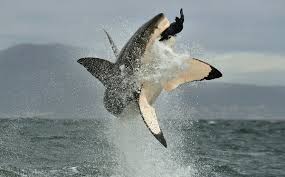Great White Sharks

- 30 Mar 2025
In News:
A 20-year study in South Africa reveals that the decline of Great White Sharks disrupted marine ecosystems, causing cascading food web imbalances.
Key Highlights:
- Scientific Name:Carcharodon carcharias
- IUCN Red List Status:Vulnerable
- Habitat and Distribution:
- Commonly found in temperate coastal waters, including regions off the USA, South Africa, Australia, and Japan.
- Highly migratory, often venturing into tropical waters but returning to temperate zones for feeding.
- Key Biological Features:
- Endothermic Adaptation: Capable of maintaining body temperature higher than surrounding waters (regional endothermy).
- Body Structure: Streamlined, torpedo-shaped body with serrated teeth for efficient hunting.
- Feeding Behavior: Ambush predator – uses a "bite-and-wait" strategy to hunt seals, dolphins, and large fish.
- Reproduction:
- Viviparous: Gives birth to live young.
- Gestation Period: Around 12 months.
- Maturity:
- Females: Mature at 15–16 feet, around 12–18 years of age.
- Males: Mature at 11–13 feet, around 10 years of age.
- Ecological Importance:
- Apex Predator: Plays a crucial role in maintaining the balance of marine ecosystems by regulating populations of prey such as seals and mid-level predators.
- Indicator Species: Their presence signals the health and stability of marine ecosystems.
- Ecological Disruption in South Africa – Key Findings:
- A 20-year study in False Bay, South Africa, revealed a significant decline in Great White Shark numbers.
- This led to:
- A surge in seal populations and sevengill sharks.
- A corresponding collapse in populations of smaller sharks and fish, showcasing a trophic cascade and food web imbalance.
